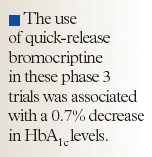- Safety & Recalls
- Regulatory Updates
- Drug Coverage
- COPD
- Cardiovascular
- Obstetrics-Gynecology & Women's Health
- Ophthalmology
- Clinical Pharmacology
- Pediatrics
- Urology
- Pharmacy
- Idiopathic Pulmonary Fibrosis
- Diabetes and Endocrinology
- Allergy, Immunology, and ENT
- Musculoskeletal/Rheumatology
- Respiratory
- Psychiatry and Behavioral Health
- Dermatology
- Oncology
From the 67th annual scientific sessions of the American Diabetes Association: Quick-release bromocriptine has favorable cardiovascular safety profile
A quick-release formulation of bromocriptine reduces the incidence of diabetic cardiovascular complications in patients with type 2 diabetes and improves glycemic control in those patients who did not achieve HbA1c <7.5% with metformin plus a sulfonylurea.

Key Points
A quick-release formulation of bromocriptine reduces the incidence of diabetic cardiovascular complications in patients with type 2 diabetes and improves glycemic control in those patients who did not achieve HbA1c <7.5% with metformin plus a sulfonylurea, according to J. Michael Gaziano, MD, MPH, a cardiologist at Brigham and Women's Hospital, Boston, Massachusetts, and Veterans Affairs Boston Healthcare System.

Bromocriptine is approved for the treatment of hyperprolactinemia-associated dysfunctions, acromegaly, and Parkinson disease.
Bromocriptine is a dopamine D2 receptor agonist. Dr Gaziano said preclinical data suggest that decreased hypothalamic dopaminergic tone may be involved in the patho-genesis of insulin resistance.
According to Dr Gaziano, the normal circadian cycle that results in a leaner body in the summer and a heavier body in the winter has been disrupted in humans because of abundant caloric intake year-round. This disruption, he said, has led to the lack of a lean phase. Stimulation of the hypothalamus promotes the release of several hormones that respond to the traditional shift in caloric intake and storage. "Quick-release bromocriptine, given once in the morning, stimulates the hypothalamus to release cortisol, growth hormone, and prolactin, allowing a reset of the circadian clock that is permanently stuck in a winter rhythm," Dr Gaziano said.
The result, according to Dr Gaziano, is the occurence of lower peaks in blood glucose and triglycerides after meals, as observed in previous phase 3 studies of quick-release bromocriptine. The use of quick-release bromocriptine in these phase 3 trials was associated with a 0.7% decrease in HbA1c levels.
The double-blind phase 3b study included 3,070 patients with type 2 diabetes who were being treated with ≤2 oral hypoglycemic agents, insulin monotherapy, or insulin plus an oral agent. The patients were randomized in a 2:1 ratio to bromocriptine, titrated up to a maximum tolerated dose of 4.8 mg/d, or placebo for 52 weeks.
There was no significant difference in the occurrence of serious adverse events between the groups (bromocriptine, 8.6%; and placebo, 9.6%; adjusted HR=1.02).
The incidence of the composite cardiovascular end point of myocardial infarction (MI), stroke, coronary revascularization, and hospitalization for congestive heart failure (CHF) or unstable angina was 1.5% among patients receiving bromocriptine and 3.0% among patients receiving placebo.
"This agent lowers the incidence of MI, stroke, and vascular events in a way we have not seen with other antidiabetic agents," Dr Gaziano said.
A prespecified secondary analysis included 192 study patients who had baseline HbA1c ≥7.5% despite treatment with metformin and a sulfonylurea. This secondary analysis assessed bromocriptine's ability to reduce HbA1c levels after 24 weeks of therapy.
Use of bromocriptine was associated with a mean reduction in HbA1c of –0.69% compared with placebo (P=.0002) and a mean reduction of –0.67% from baseline. A total of 39% of the bromocriptine recipients achieved the American Diabetes Association HbA1c target of 7.0% compared with 11% of patients in the placebo group (P=.0004).
"The impact of this drug is that we may usher in a whole new approach to treating diabetes-attacking it upstream [centrally]," Dr Gaziano said. "It has a big impact on things we really care about. Not only do the sugars look good but it prevents events that kill the majority of patients with diabetes."
VeroScience, the manufacturer of bromocriptine, indicated that it intends to file an amended NDA for bromocriptine with FDA during the late third or fourth quarter of 2007.
SOURCE
Phase IIIb clinical data validate the overall and cardiovascular safety profile of Cycloset (a quick release formulation of bromocriptine mesylate) in patients with type 2 diabetes [press release]. Chicago, IL: PRNewswire/VeroScience, LLC; June 23, 2007.
